Research on the Effect of Desert Sand on Pore Structure of Fiber Reinforced Mortar Based on X-CT Technology
Abstract
:1. Introduction
2. Materials and Methods
2.1. Raw Materials
2.2. Test Methods
2.2.1. Compressive Strength
2.2.2. Mercury Intrusion Porosimetry (MIP)
2.2.3. μX-CT
Porosity Calculation Based on Two-Dimensional CT Images
Modeling and Analysis of Pore Structure Based on Avizo Software
3. Results and Discussion
3.1. Compressive Strength
3.2. Analysis of MIP
3.3. Analysis of μX-CT
3.3.1. Pore Characteristic Analysis Based on Two-Dimensional CT Images
3.3.2. Pore Structure Analysis Based on 3D Modeling
3.4. Discussion
4. Conclusions
- This paper studied the effect of desert sand on fiber reinforced mortar. The compressive strength increases first and then decreases at different rates with the increase of desert sand replacement rate. After curing for 28 days, relative to river sand mortar, the increment of compressive strength of fiber reinforced mortar with 25%, 50%, 75%, and 100% desert sand replacement rate is 8.61%, 11.90%, 8.96%, and 2.28%, respectively. Mortar with 50% desert sand replacement rate has the highest compressive strength, up to 98.7 MPa, which has a positive effect on the application of desert sand in concrete.
- MIP and μX-CT techniques were used to study the pore structure of fiber reinforced mortar with different desert sand replacement rate. The changes of pore structure characteristics obtained by MIP and μX-CT are basically consistent. The MIP technique was used to study the pore structure characteristics from 1 nm to 500 μm, and the pore size changes are mainly distributed in the range of 1–100 nm and over 200 μm. It is found that when the replacement rate of desert sand exceeds 50%, the pore structure characteristics measured by MIP in the range of 1 nm to 100 nm are worse than those of the reference group, indicating that the pore structure characteristics are inferior to those of pure river sand fiber reinforced mortar. The μX-CT technique was used to investigate the pore structure characteristics above 200 μm. The pores in this range are more harmful pores and have a great influence on the strength of cement mortar. When the replacement rate of desert sand exceeds 50%, the pore structure becomes worse in the range of 200 μm, but it is still better than pure river sand group. This indicates that the pore over than 200 μm has a greater influence on the strength of fiber reinforced mortar.
- Two methods were used to analyze the pore structure of samples based on μX-CT technique. The first method calculates the porosity of each CT image to obtain the porosity at different depths and total porosity. The second method models the pore structure based on Avizo software to obtain a three-dimensional model of the pore structure. The changes of pore structure characteristics obtained by the two methods are basically the same, and the porosity values remain the same. In comparison, it is an efficient and convenient method to analyze the pore structure of concrete by 3D modeling. It cannot only make the pore structure of samples become visualized and more intuitively observe the changes of the pore structure, but also quantitatively analyze the pore structure of samples through the data analysis method in the Avizo software.
- The compressive strength of fiber reinforced mortar with different desert sand re-placement rate decreases with the increase of porosity. When the desert sand replacement rate is 50%, the sample has the lowest porosity, the best pore structure characteristics, and the highest compressive strength. The optimization of pore structure can effectively improve the microstructure of cement mortar, make the microstructure of cement mortar become more compact, and improve the compressive strength.
Author Contributions
Funding
Institutional Review Board Statement
Informed Consent Statement
Data Availability Statement
Conflicts of Interest
References
- Cao, C.; Li, Y.H. Crazy Aggregates. China Econ. Wkly. 2014, 18, 28–32. (In Chinese) [Google Scholar]
- Macfarlane, M.; Mitchell, P. Scoping and Assessment of the Environmental and Social Impacts of River Mining in Jamaica; Proceedings of the MERN Working Paper; University of Warwick: Warwick, UK, 2003. [Google Scholar]
- Du, Y.G. Rearch on Frost Resistance of Desert Sand Concrete; Ningxia University: Yinchuan, China, 2018. (In Chinese) [Google Scholar]
- Kaufmann, J. Evaluation of the combination of desert sand and calcium sulfoaluminate cement for the production of concrete. Constr. Buiding Mater. 2020, 243, 118281. [Google Scholar] [CrossRef]
- Zhang, G.X.; Song, J.X.; Yang, W.W.; Yang, J.S.; Jia, J.; Zhang, X.T.; Cui, Z.Z. Effects of Different Desert Sand on Properties of Cement Mortar and Concrete; Natural Science, Ed.; Ningxia University: Yinchuan, China, 2003; Volume 1, pp. 63–65. (In Chinese) [Google Scholar]
- Jin, B.H.; Song, J.X.; Liu, H.F. Engineering Characteristics of Concrete Made of Desert Sand from Maowusu Sandy Land. Appl. Mech. Mater. 2012, 1801, 604–607. [Google Scholar] [CrossRef]
- Che, J.; Wang, D.; Liu, H.; Zhang, Y. Mechanical Properties of Desert Sand-Based Fiber Reinforced Concrete (DS-FRC). Appl. Sci. 2019, 9, 1857. [Google Scholar] [CrossRef] [Green Version]
- Seif, E.S.S.A. Assessing the engineering properties of concrete made with fine dune sands: An experimental study. Arab. J. Geosci. 2013, 6, 857–863. [Google Scholar] [CrossRef]
- Luo, F.J.; He, L.; Pan, Z.; Duan, W.H.; Zhao, X.L.; Collins, F. Effect of very fine particles on workability and strength of concrete made with dune sand. Constr. Build. Mater. 2013, 47, 131–173. [Google Scholar] [CrossRef]
- Arroudj, K.; Zenati, A.; Oudjit, M.N.; Bali, A.; Tagnit-Hamou, A. Reactivity of Fine Quartz in Presence of Silica Fume and Slag. Engineering 2011, 3, 569–576. [Google Scholar] [CrossRef] [Green Version]
- Yang, W.; Chen, Y.; Liu, H.; Ma, J.; Han, L.; Song, J. Research on the mechanical properties of desert sand high strength concrete. Concrete 2014, 11, 100–102. [Google Scholar]
- Kearsley, E.P.; Wainwright, P.J. The effect of porosity on the strength of foamed concrete. Cem. Concr. Res. 2002, 32, 233–239. [Google Scholar] [CrossRef]
- Kumar, R.; Bhattacharjee, B. Porosity, pore size distribution and in situ strength of concrete. Cem. Concr. Res. 2003, 33, 155–164. [Google Scholar] [CrossRef]
- Lian, C.; Zhuge, Y.; Beecham, S. The relationship between porosity and strength for porous concrete. Constr. Build. Mater. 2011, 25, 4294–4298. [Google Scholar] [CrossRef]
- Marfisi, E.; Burgoyne, C.J.; Amin, M.H.G.; Hall, L.D. The use of MRI to observe the structure of concrete. Mag. Concr. Res. 2005, 57, 101–109. [Google Scholar] [CrossRef]
- Lian, H.; Tong, L.; Chen, E. Research Basis of the Phase of Building Materials; Publishing House of Tsinghua University: Beijing, China, 1996. (In Chinese) [Google Scholar]
- O’Farrell, M.; Wild, S.; Sabir, B.B. Pore size distribution and compressive strength of waste clay brick mortar. Cem. Concr. Compos. 2001, 23, 81–89. [Google Scholar] [CrossRef]
- Shi, C. Strength, pore structure and permeability of alkali-activated slag mortars. Cem. Concr. Res. 1996, 26, 1789–1799. [Google Scholar] [CrossRef]
- Wen, C.E.; Yamada, Y.; Shimojima, K.; Chino, Y.; Hosokawa, H.; Mabuchi, M. Compressibility of porous magnesium foam: Dependency on porosity and pore size. Mater. Lett. 2004, 58, 357–360. [Google Scholar] [CrossRef]
- Liu, R.; Chi, Y.; Chen, S.; Jiang, Q.; Meng, X.; Wu, K.; Li, S. Influence of Pore Structure Characteristics on the Mechanical and Durability Behavior of Pervious Concrete Material Based on Image Analysis. Int. J. Concr. Struct. Mater. 2020, 14, 869–974. [Google Scholar] [CrossRef]
- Bu, J.; Tian, Z. Relationship between pore structure and compressive strength of concrete: Experiments and statistical modeling. Sadhana-Acad. Proc. Eng. Sci. 2016, 41, 337–344. [Google Scholar] [CrossRef] [Green Version]
- Jin, S.; Zhang, J.; Chen, C.; Chen, W. Study of Pore Fractal Characteristic of Cement Mortar. J. Build. Mater. 2011, 14, 92–97. [Google Scholar]
- Liu, F.; Wang, B.; Wang, M.; Yuan, X. Analysis on Pore Structure of Non-Dispersible Underwater Concrete in Saline Soil Area. J. Renew. Mater. 2021, 9, 723–742. [Google Scholar] [CrossRef]
- Bossa, N.; Chaurand, P.; Vicente, J.; Borschneck, D.; Levard, C.; Aguerre-Chariol, O.; Rose, J. Micro- and nano-X-ray computed-tomography: A step forward in the characterization of the pore network of a leached cement paste. Cem. Concr. Res. 2015, 67, 138–147. [Google Scholar] [CrossRef]
- Chotard, T.J.; Boncoeur-Martel, M.P.; Smith, A.; Dupuy, J.P.; Gault, C. Application of X-ray computed tomography to characterise the early hydration of calcium aluminate cement. Cem. Concr. Compos. 2003, 25, 145–152. [Google Scholar] [CrossRef]
- Gallucci, E.; Scrivener, K.; Groso, A.; Stampanoni, M.; Margaritondo, G. 3D experimental investigation of the microstructure of cement pastes using synchrotron X-ray microtomography (μCT). Cem. Concr. Res. 2006, 37, 360–368. [Google Scholar] [CrossRef]
- Promentilla, M.A.B.; Sugiyama, T.; Hitomi, T.; Takeda, N. Quantification of tortuosity in hardened cement pastes using synchrotron-based X-ray computed microtomography. Cem. Concr. Res. 2009, 39, 548–557. [Google Scholar] [CrossRef] [Green Version]
- Sugiyama, T.; Promentilla, M.A.B.; Hitomi, T.; Takeda, N. Application of synchrotron microtomography for pore structure characterization of deteriorated cementitious materials due to leaching. Cem. Concr. Res. 2009, 40, 1265–1270. [Google Scholar] [CrossRef]
- Wang, J.; Dewanckele, J.; Cnudde, V.; Vlierberghe, S.V.; Verstraete, W.; Belie, N.D. X-ray computed tomography proof of bacterial-based self-healing in concrete. Cem. Concr. Compos. 2014, 53, 289–304. [Google Scholar] [CrossRef]
- Chen, H.Q.; Ding, W.H.; Dang, F.N.; Yin, X.T. Quantitative analysis of equivalent crack region in CT images of concrete. J. China Inst. Water Resour. Hydropower Res. 2006, 1, 1–7. (In Chinese) [Google Scholar]
- Tian, W.; Dang, F.N.; Ding, W.H.; Liang, X.Y.; Chen, H.Q. Development of a dynamic loading apparatus for CT experiment and its application. Adv. Civ. Eng. 2010, 31, 309–313. (In Chinese) [Google Scholar]
- Fu, J.; Yu, Y. Experimental Study on Pore Characteristics and Fractal Dimension Calculation of Pore Structure of Aerated Concrete Block. Adv. Civ. Eng. 2019, 2019, 8043248. [Google Scholar] [CrossRef] [Green Version]
- Wang, R.; Gao, X.; Zhang, J.; Han, G. Spatial distribution of steel fibers and air bubbles in UHPC cylinder determined by X-ray CT method. Constr. Build. Mater. 2018, 160, 39–47. [Google Scholar] [CrossRef]
- Kang, S.H.; Hong, S.G.; Moon, J. The effect of superabsorbent polymer on various scale of pore structure in ultra-high performance concrete. Constr. Build. Mater. 2018, 172, 29–40. [Google Scholar] [CrossRef]
- Stovall, T.; de Larrard, F.L.; Buil, M. Linear packing density model of grain mixtures. Powder Technol. 1986, 48, 1–12. [Google Scholar] [CrossRef]
- Wu, Z.W.; Zhang, H.Z. Expansion Concrete; China Railway Publishing House: Beijing, China, 1990. (In Chinese) [Google Scholar]
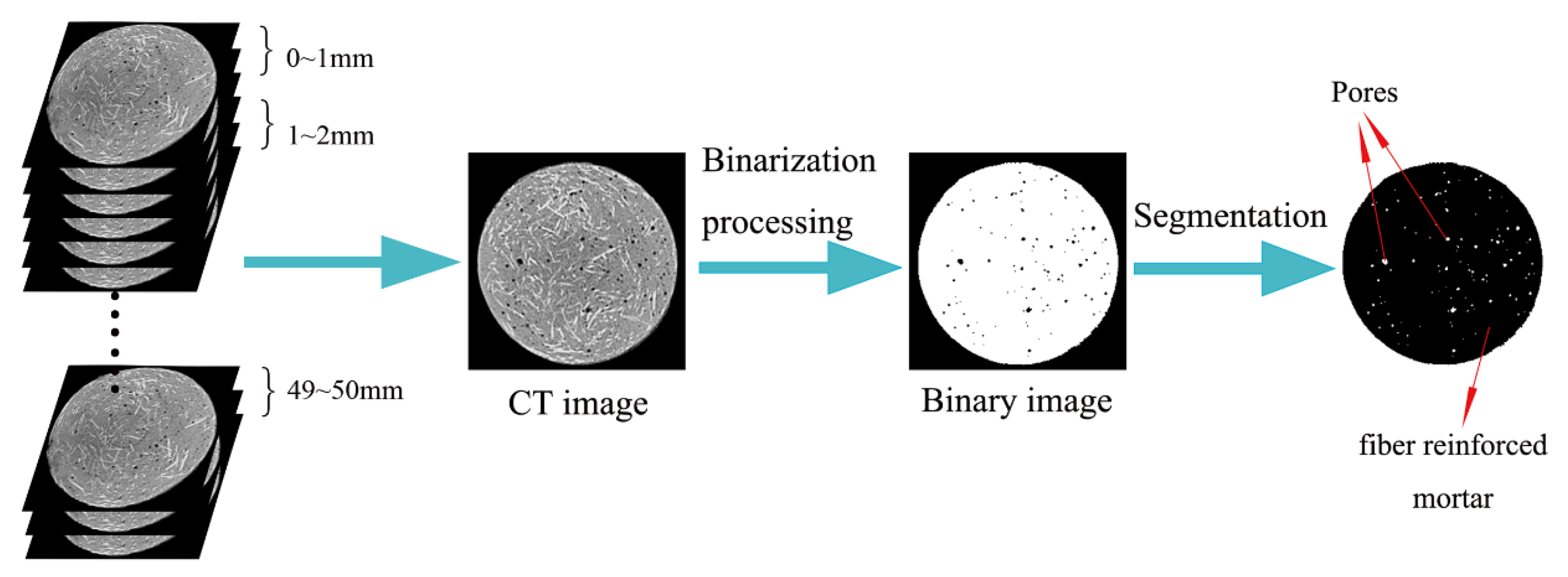



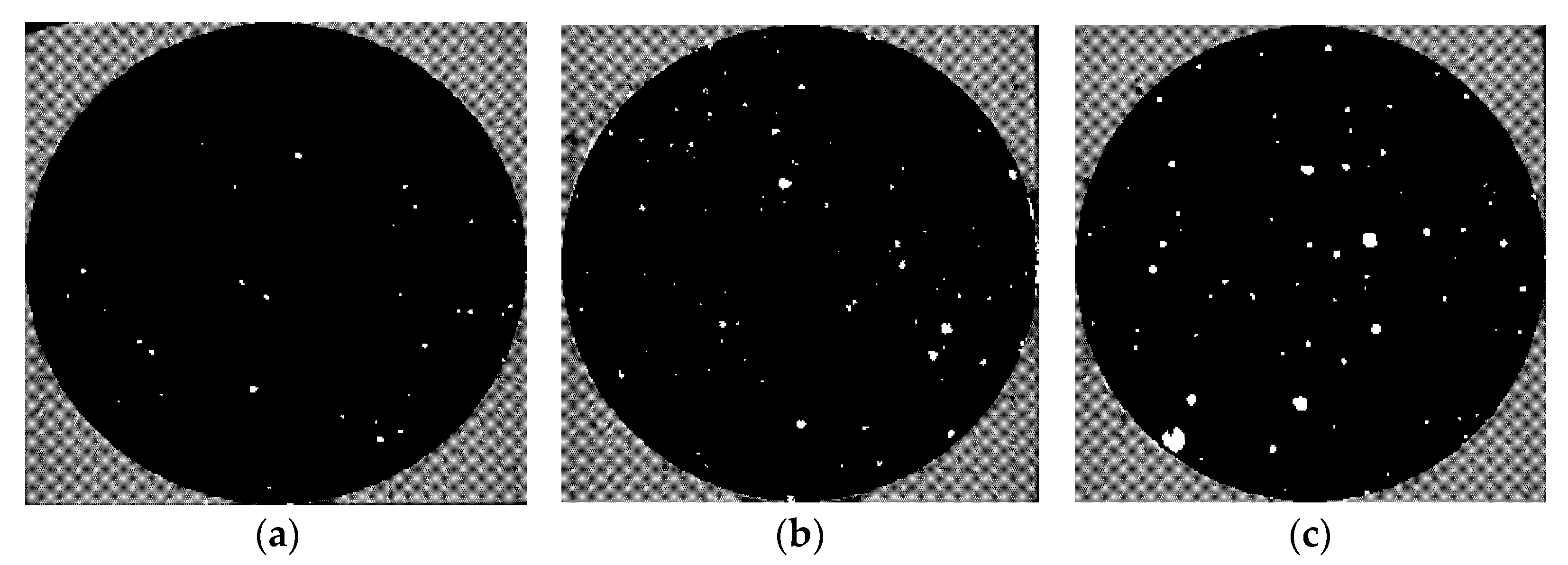

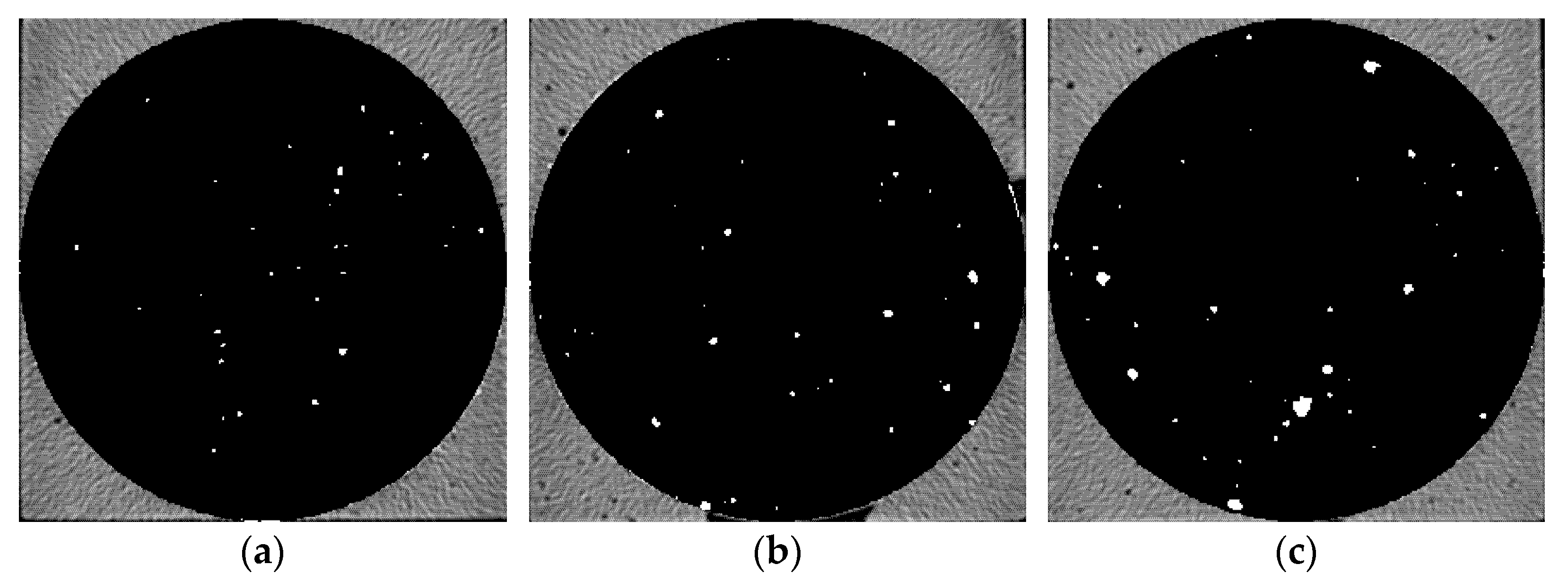
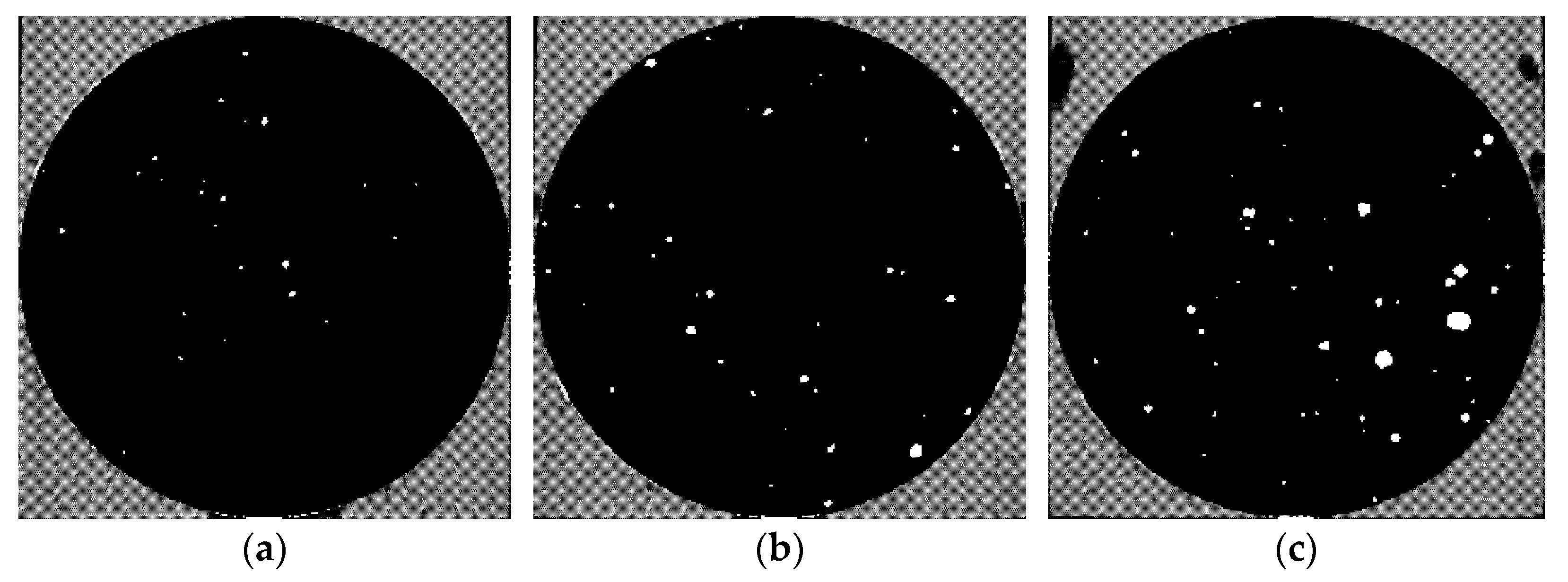
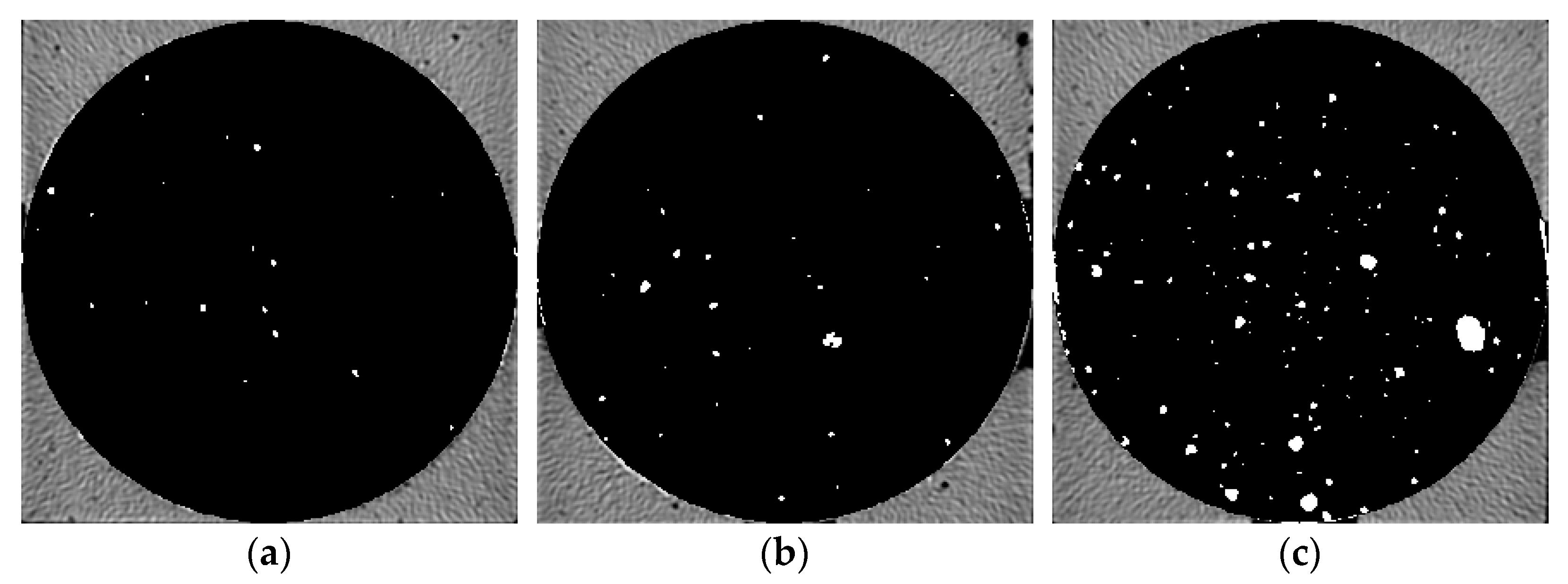
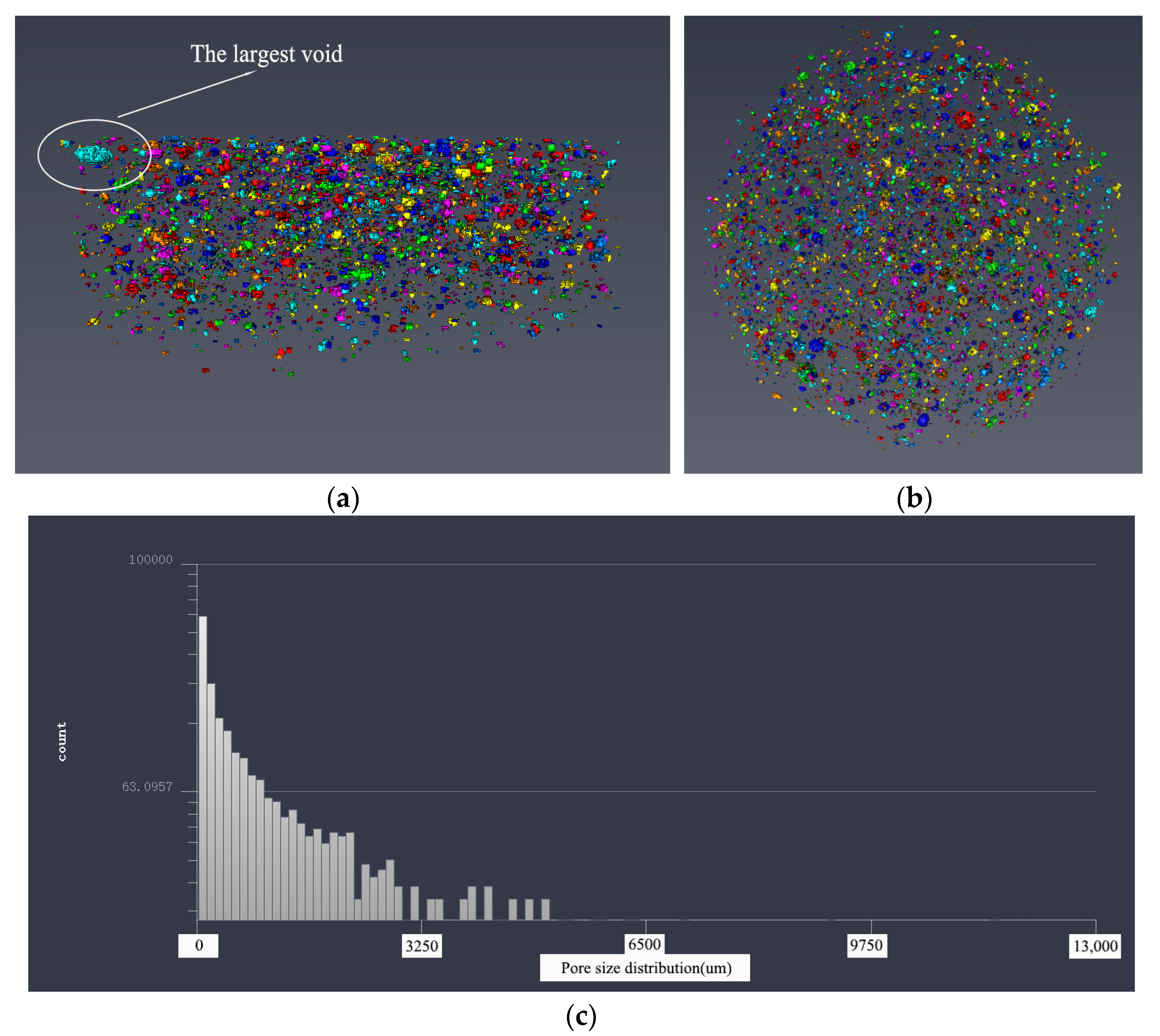
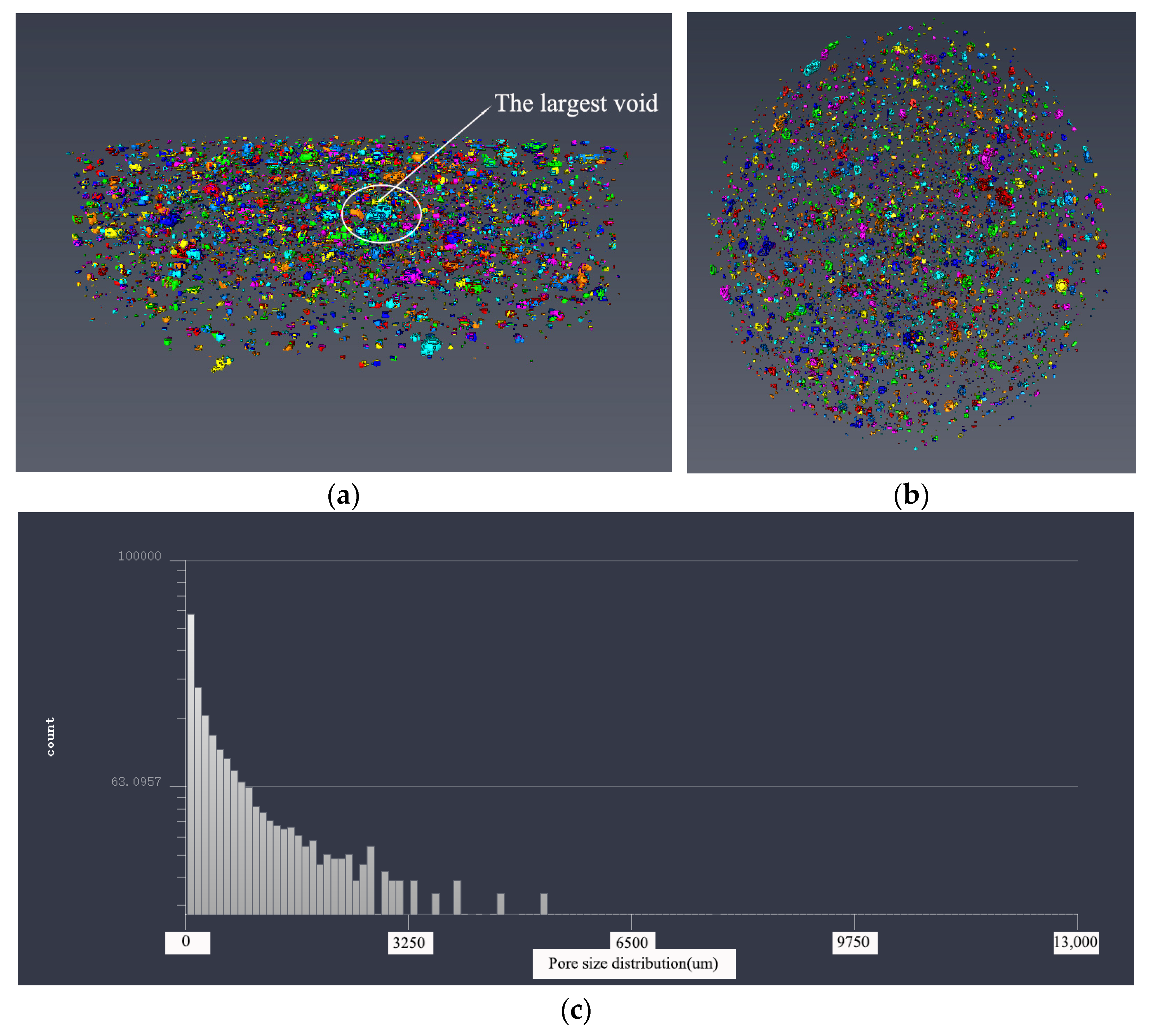
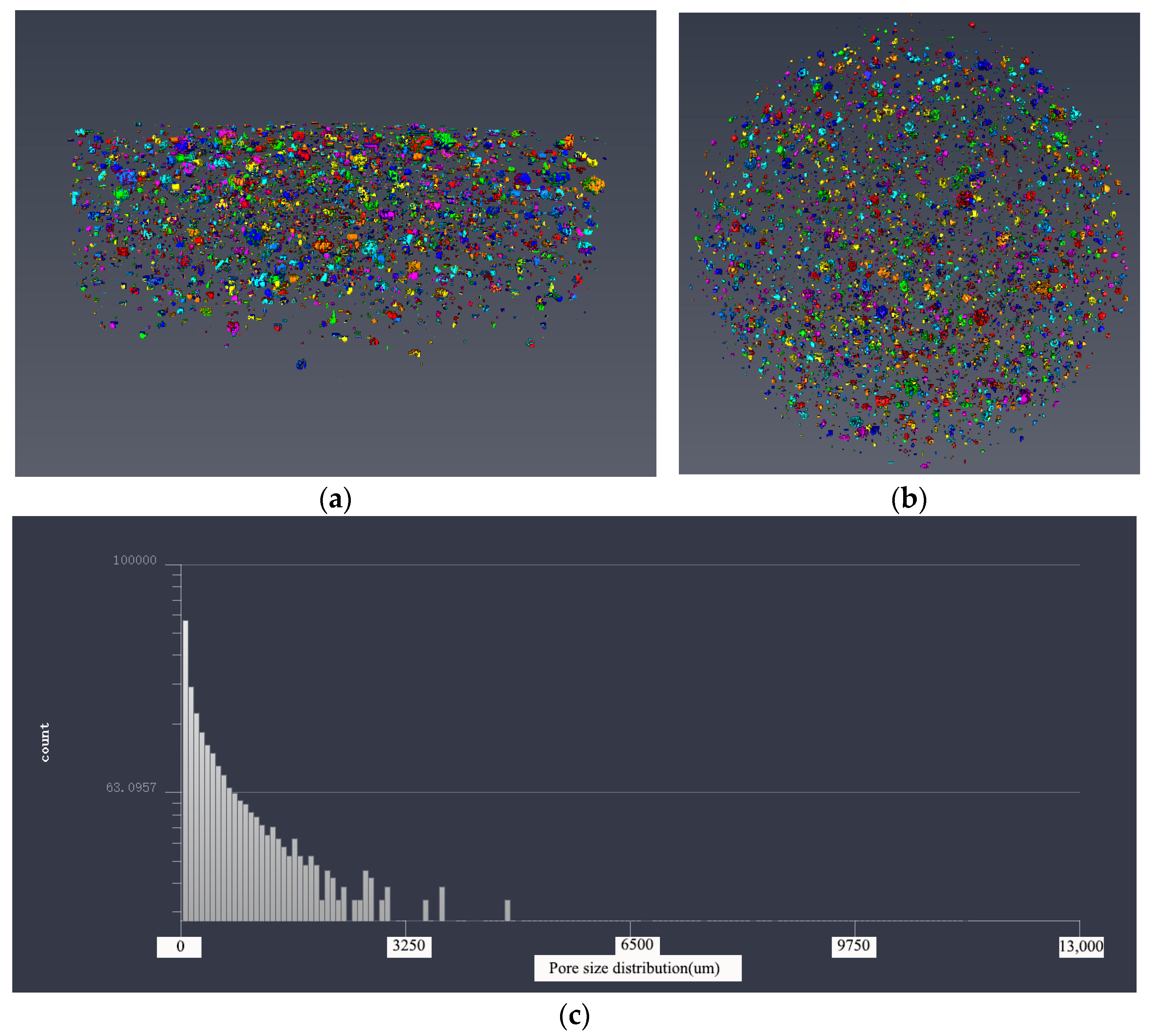
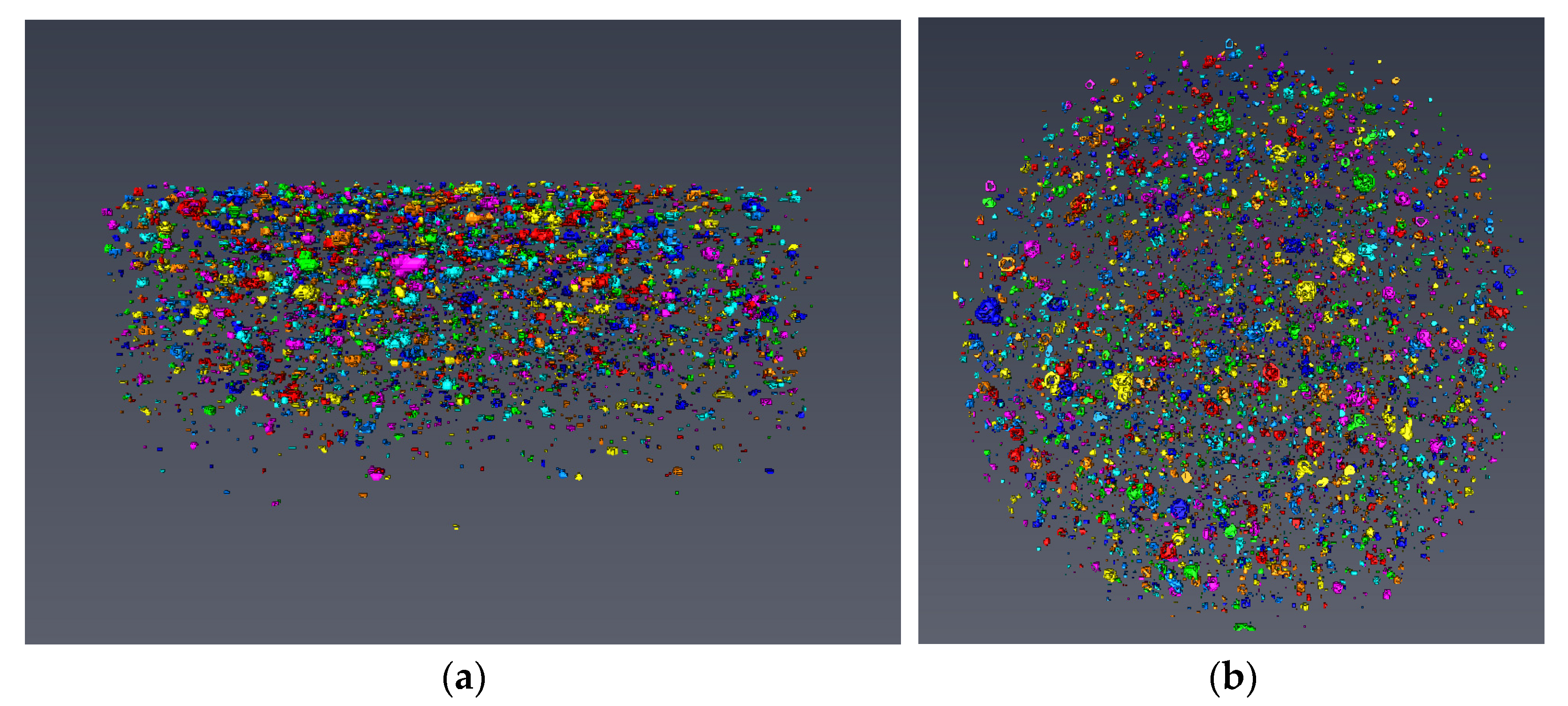

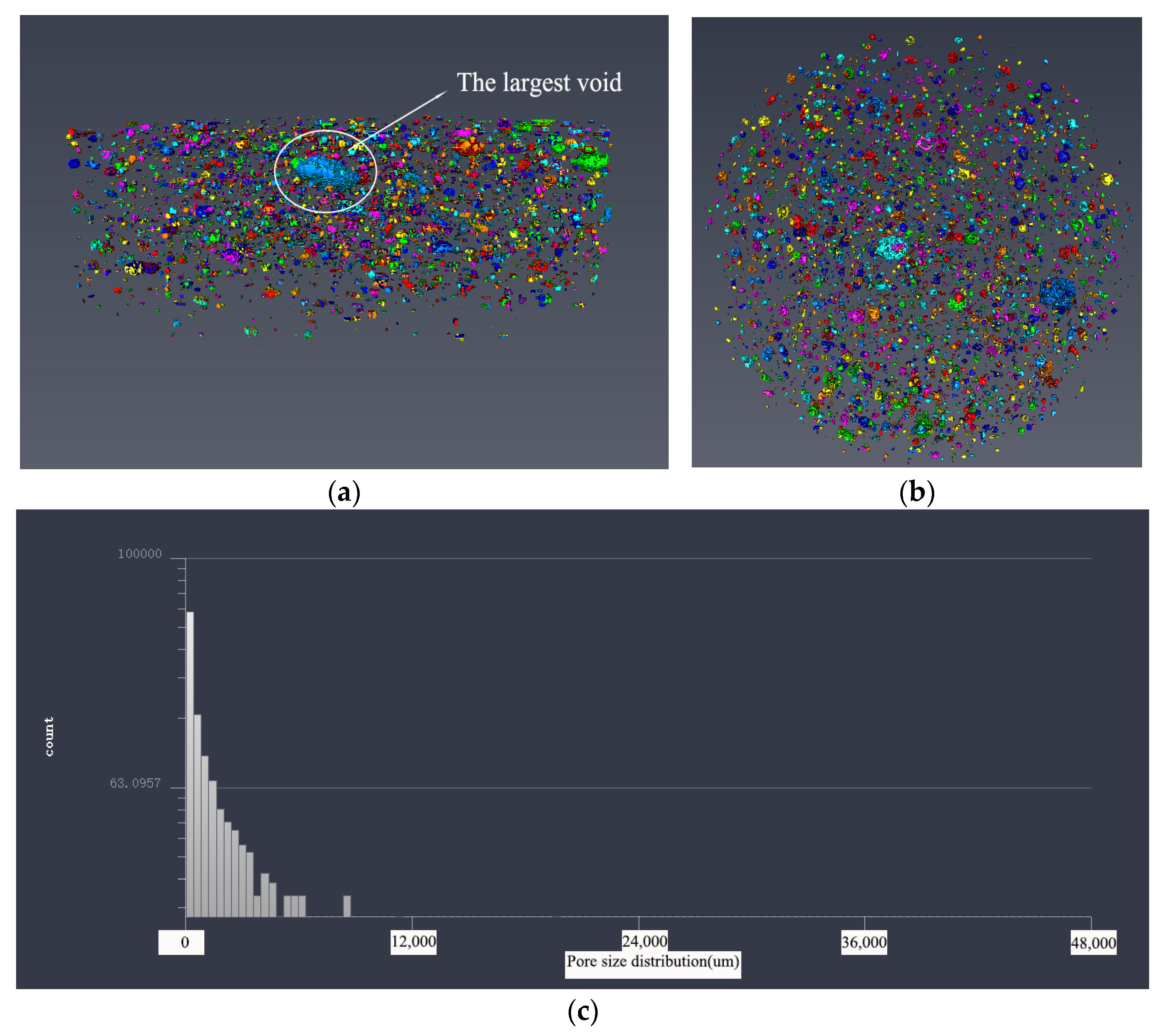

| Items | Chemical Composition/% | Ignition Loss Rate | Specific Surface Area/(cm2/g) | Packing Density/(g/cm3) | ||||||
|---|---|---|---|---|---|---|---|---|---|---|
| CaO | SiO2 | Al2O3 | MgO | Fe2O3 | Na2O | SO3 | ||||
| Cement | 61.54 | 15.40 | 4.43 | 0.72 | 4.91 | 0.04 | 2.75 | 2.24 | 3500 | 3.1 |
| Group | Cement | Steel Fiber | Desert Sand Replacement Rate% | Desert Sand | River Sand | Deionized Water |
|---|---|---|---|---|---|---|
| 1 | 1 | 0.30 | 0 | \ | 1.2 | 0.45 |
| 2 | 1 | 0.30 | 25 | 0.3 | 0.9 | 0.45 |
| 3 | 1 | 0.30 | 50 | 0.6 | 0.6 | 0.45 |
| 4 | 1 | 0.30 | 75 | 0.9 | 0.3 | 0.45 |
| 5 | 1 | 0.30 | 100 | 1.2 | \ | 0.45 |
| Group | 1 | 2 | 3 | 4 | 5 |
|---|---|---|---|---|---|
| Porosity (%) | 14.0821 | 13.0013 | 12.7888 | 15.1259 | 16.5675 |
| Cumulative pore volume (mL/g) | 0.0729 | 0.0672 | 0.0662 | 0.0815 | 0.0928 |
| Mean diameter (nm) | 40,625 | 40,606 | 40,598 | 40,618 | 40,630 |
| Start from the Top Surface | Porosity/% | Start from the Top Surface | Porosity/% | ||||||||
|---|---|---|---|---|---|---|---|---|---|---|---|
| Group 1 | Group 2 | Group 3 | Group 4 | Group 5 | Group 1 | Group 2 | Group 3 | Group 4 | Group 5 | ||
| 0–1 mm | 3.41 | 3.04 | 2.72 | 2.85 | 3.15 | 25–26 mm | 2.78 | 2.65 | 1.60 | 1.92 | 2.51 |
| 1–2 mm | 3.34 | 3.37 | 2.53 | 2.70 | 3.12 | 26–27 mm | 2.49 | 1.98 | 1.95 | 2.10 | 2.68 |
| 2–3 mm | 3.58 | 3.34 | 2.69 | 2.74 | 3.45 | 27–28 mm | 2.80 | 1.65 | 2.25 | 2.45 | 2.82 |
| 3–4 mm | 3.62 | 3.17 | 2.70 | 3.19 | 3.41 | 28–29 mm | 2.75 | 2.56 | 2.22 | 2.41 | 2.65 |
| 4–5 mm | 3.88 | 3.26 | 2.61 | 3.21 | 3.29 | 29–30 mm | 2.56 | 2.48 | 2.26 | 1.69 | 2.50 |
| 5–6 mm | 3.56 | 3.11 | 2.70 | 3.20 | 3.13 | 30–31 mm | 2.78 | 2.40 | 2.03 | 1.71 | 2.81 |
| 6–7 mm | 3.45 | 2.97 | 2.66 | 3.33 | 3.27 | 31–32 mm | 2.30 | 1.95 | 1.69 | 1.51 | 2.77 |
| 7–8 mm | 3.41 | 2.99 | 2.91 | 2.89 | 2.91 | 32–33 mm | 2.56 | 1.85 | 1.96 | 1.43 | 2.95 |
| 8–9 mm | 3.51 | 2.96 | 2.69 | 3.04 | 3.79 | 33–34 mm | 2.48 | 1.86 | 1.06 | 1.79 | 2.80 |
| 9–10 mm | 3.55 | 2.84 | 3.21 | 2.74 | 3.96 | 34–35 mm | 2.95 | 1.56 | 1.05 | 1.46 | 2.58 |
| 10–11 mm | 3.50 | 2.74 | 2.63 | 2.83 | 4.00 | 35–36 mm | 2.54 | 1.59 | 1.28 | 1.20 | 2.70 |
| 11–12 mm | 3.56 | 2.79 | 2.65 | 2.98 | 3.74 | 36–37 mm | 2.39 | 1.48 | 1.19 | 1.57 | 2.06 |
| 12–13 mm | 3.34 | 2.99 | 2.74 | 2.90 | 3.27 | 37–38 mm | 2.30 | 1.33 | 1.26 | 1.57 | 2.05 |
| 13–14 mm | 3.59 | 3.12 | 2.50 | 2.96 | 2.97 | 38–39 mm | 2.56 | 1.43 | 1.15 | 1.07 | 2.58 |
| 14–15 mm | 3.45 | 3.05 | 2.65 | 3.02 | 2.90 | 39–40 mm | 1.96 | 1.08 | 1.12 | 1.39 | 2.70 |
| 15–16 mm | 3.56 | 2.65 | 2.25 | 1.92 | 2.53 | 40–41 mm | 1.89 | 1.12 | 1.29 | 1.62 | 2.06 |
| 16–17 mm | 3.55 | 2.75 | 2.36 | 1.71 | 2.49 | 41–42 mm | 1.41 | 1.26 | 1.35 | 1.88 | 1.89 |
| 17–18 mm | 3.23 | 2.99 | 2.71 | 2.57 | 2.42 | 42–43 mm | 1.30 | 1.26 | 1.04 | 2.29 | 1.64 |
| 18–19 mm | 3.26 | 3.01 | 1.60 | 2.58 | 3.14 | 43–44 mm | 1.21 | 1.94 | 1.05 | 1.43 | 1.41 |
| 19–20 mm | 3.10 | 2.91 | 1.51 | 1.79 | 3.05 | 44–45 mm | 1.32 | 1.55 | 1.03 | 1.27 | 1.36 |
| 20–21 mm | 2.77 | 2.90 | 1.79 | 1.60 | 2.99 | 45–46 mm | 1.20 | 1.06 | 1.11 | 1.14 | 1.40 |
| 21–22 mm | 2.78 | 2.81 | 1.65 | 1.92 | 2.60 | 46–47 mm | 1.04 | 1.05 | 1.03 | 1.01 | 1.25 |
| 22–23 mm | 2.51 | 2.86 | 1.95 | 2.33 | 2.53 | 47–48 mm | 1.02 | 1.00 | 0.97 | 1.05 | 1.21 |
| 23–24 mm | 2.65 | 2.65 | 2.26 | 1.79 | 2.42 | 48–49 mm | 0.89 | 0.85 | 0.74 | 0.74 | 0.96 |
| 24–25 mm | 2.61 | 2.61 | 1.89 | 1.60 | 2.73 | 49–50 mm | 0.74 | 0.73 | 0.69 | 0.73 | 0.75 |
| The upper area | 3.51 | 3.02 | 2.68 | 2.91 | 3.30 | \ | \ | \ | \ | \ | \ |
| The middle area | 2.80 | 2.57 | 1.98 | 1.99 | 2.69 | \ | \ | \ | \ | \ | \ |
| The bottom area | 1.76 | 1.33 | 1.13 | 1.37 | 1.91 | \ | \ | \ | \ | \ | \ |
| Average | 2.70 | 2.27 | 1.89 | 2.09 | 2.64 | \ | \ | \ | \ | \ | \ |
| Group | 1 | 2 | 3 | 4 | 5 |
|---|---|---|---|---|---|
| Porosity | 2.02% | 1.92% | 1.84% | 1.89% | 1.85% |
| Pore size Distribution(μm) | 254.273–4959.207 | 176.27–4883.869 | 233.89–3485.766 | 176.27–3695.517 | 176.27–8232.703 |
| Mean Pore Volume(mm3) | 0.2094 | 0.1960 | 0.1906 | 0.2009 | 0.2052 |
| Min Pore Volume(mm3) | 0.0412 | 0.0412 | 0.0412 | 0.0399 | 0.0401 |
| Max Pore Volume(mm3) | 87.8677 | 66.4778 | 25.9235 | 15.6972 | 90.8732 |
Publisher’s Note: MDPI stays neutral with regard to jurisdictional claims in published maps and institutional affiliations. |
© 2021 by the authors. Licensee MDPI, Basel, Switzerland. This article is an open access article distributed under the terms and conditions of the Creative Commons Attribution (CC BY) license (https://creativecommons.org/licenses/by/4.0/).
Share and Cite
Shi, F.; Li, T.; Wang, W.; Liu, R.; Liu, X.; Tian, H.; Liu, N. Research on the Effect of Desert Sand on Pore Structure of Fiber Reinforced Mortar Based on X-CT Technology. Materials 2021, 14, 5572. https://doi.org/10.3390/ma14195572
Shi F, Li T, Wang W, Liu R, Liu X, Tian H, Liu N. Research on the Effect of Desert Sand on Pore Structure of Fiber Reinforced Mortar Based on X-CT Technology. Materials. 2021; 14(19):5572. https://doi.org/10.3390/ma14195572
Chicago/Turabian StyleShi, Fangying, Tianyu Li, Weikang Wang, Ruidan Liu, Xiaoyan Liu, Huiwen Tian, and Nazhen Liu. 2021. "Research on the Effect of Desert Sand on Pore Structure of Fiber Reinforced Mortar Based on X-CT Technology" Materials 14, no. 19: 5572. https://doi.org/10.3390/ma14195572
APA StyleShi, F., Li, T., Wang, W., Liu, R., Liu, X., Tian, H., & Liu, N. (2021). Research on the Effect of Desert Sand on Pore Structure of Fiber Reinforced Mortar Based on X-CT Technology. Materials, 14(19), 5572. https://doi.org/10.3390/ma14195572








